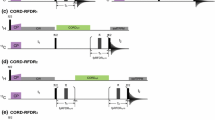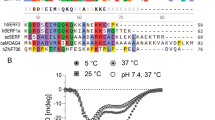Abstract
Co-solute paramagnetic relaxation enhancement (PRE) is an attractive way to speed up data acquisition in NMR spectroscopy by shortening the T 1 relaxation time of the nucleus of interest and thus the necessary recycle delay. Here, we present the rationale to utilize high-spin iron(III) as the optimal transition metal for this purpose and characterize the properties of its neutral chelate form Fe(DO3A) as a suitable PRE agent. Fe(DO3A) effectively reduces the T 1 values across the entire sequence of the intrinsically disordered protein α-synuclein with negligible impact on line width. The agent is better suited than currently used alternatives, shows no specific interaction with the polypeptide chain and, due to its high relaxivity, is effective at low concentrations and in ‘proton-less’ NMR experiments. By using Fe(DO3A) we were able to complete the backbone resonance assignment of a highly fibrillogenic peptide from α1-antitrypsin by acquiring the necessary suite of multidimensional NMR datasets in 3 h.







Similar content being viewed by others
References
Abragam A (1961) The principles of nuclear magnetism. International series of monographs on physics. Clarendon Press, Oxford
Bermel W, Bertini I, Felli I, Piccioli M, Pierattelli R (2006a) 13C-detected protonless NMR spectroscopy of proteins in solution. Prog Nucl Magn Reson Spectrosc 48:25–45
Bermel W, Bertini I, Felli IC, Lee YM, Luchinat C, Pierattelli R (2006b) Protonless NMR experiments for sequence-specific assignment of backbone nuclei in unfolded proteins. J Am Chem Soc 128:3918–3919
Bertini I, Luchinat C, Parigi G (2001) Solution NMR of paramagnetic molecules: applications to metallobiomolecules and models, vol 2. Elsevier, Amsterdam
Cai S, Seu C, Kovacs Z, Sherry AD, Chen Y (2006) Sensitivity enhancement of multidimensional NMR experiments by paramagnetic relaxation effects. J Am Chem Soc 128:13474–13478
Caravan P (2009) Protein-targeted gadolinium-based magnetic resonance imaging (MRI) contrast agents: design and mechanism of action. Acc Chem Res 42:851–862
Chang CA, Francesconi LC, Malley MF, Kumar K, Gougoutas JZ, Tweedle MF (1993) Synthesis, characterization, and crystal structure of M(DO3A) (M = Fe, Gd) and Na[M(DOTA)] (M = Fe, Y, Gd). Inorg Chem 32:3501–3508
Delaglio F, Grzesiek S, Vuister GW, Zhu G, Pfeifer J, Bax A (1995) NMRPipe: a multidimensional spectral processing system based on UNIX pipes. J Biomol NMR 6:277–293
Dichtl W, Moraga F, Ares MP, Crisby M, Nilsson J, Lindgren S, Janciauskiene S (2000) The carboxyl-terminal fragment of alpha1-antitrypsin is present in atherosclerotic plaques and regulates inflammatory transcription factors in primary human monocytes. Mol Cell Biol Res Commun 4:50–61. doi:10.1006/mcbr.2000.0256
Diercks T, Daniels M, Kaptein R (2005) Extended flip-back schemes for sensitivity enhancement in multidimensional HSQC-type out-and-back experiments. J Biomol NMR 33:243–259
Elliott PR, Pei XY, Dafforn TR, Lomas DA (2000) Topography of a 2.0 Å structure of alpha1-antitrypsin reveals targets for rational drug design to prevent conformational disease. Protein Sci 9:1274–1281. doi:10.1110/ps.9.7.1274
Ernst RR, Bodenhausen G, Wokaun A (1987) Principles of nuclear magnetic resonance in one and two dimensions. International series of monographs on chemistry, vol 14. Clarendon Press, Oxford
Fawzi NL, Ying J, Torchia DA, Clore GM (2010) Kinetics of amyloid beta monomer-to-oligomer exchange by NMR relaxation. J Am Chem Soc 132:9948–9951. doi:10.1021/ja1048253
Freed JH (1978) Dynamic effects of pair correlation-functions on spin relaxation by translational diffusion in liquids. 2. Finite jumps and independent T1 processes. J Chem Phys 68:4034–4037. doi:10.1063/1.436302
Gil S, Hosek T, Solyom Z, Kummerle R, Brutscher B, Pierattelli R, Felli IC (2013) NMR spectroscopic studies of intrinsically disordered proteins at near-physiological conditions. Angew Chem Int Ed Engl 52:11808–11812. doi:10.1002/anie.201304272
Goddard TD, Kneller DG (2003) SPARKY 3. University California, San Fransisco
Hocking HG, Zangger K, Madl T (2013) Studying the structure and dynamics of biomolecules by using soluble paramagnetic probes. ChemPhysChem 14:3082–3094. doi:10.1002/cphc.201300219
Hsu ST, Bertoncini CW, Dobson CM (2009) Use of protonless NMR spectroscopy to alleviate the loss of information resulting from exchange-broadening. J Am Chem Soc 131:7222–7223
Huskens J, Torres DA, Kovacs Z, Andre JP, Geraldes CF, Sherry AD (1997) Alkaline earth metal and lanthanide(III) complexes of ligands based upon 1,4,7,10-tetraazacyclododecane-1,7-bis(acetic acid). Inorg Chem 36:1495–1503
Janciauskiene S, Carlemalm E, Eriksson S (1995) In vitro fibril formation from alpha 1-antitrypsin-derived C-terminal peptides. Biol Chem Hoppe-Seyler 376:415–423
Johansson J, Grondal S, Sjovall J, Jornvall H, Curstedt T (1992) Identification of hydrophobic fragments of alpha 1-antitrypsin and C1 protease inhibitor in human bile, plasma and spleen. FEBS Lett 299:146–148
Kay LE, Keifer P, Saarinen T (1992) Pure absorption gradient enhanced heteronuclear single quantum spectroscopy with improved sensitivity. J Am Chem Soc 114:10633–10635
Kumar K, Chang CA, Francesconi LC, Dischino DD, Malley MF, Gougoutas JZ, Tweedle MF (1994) Synthesis, stability, and structure of gadolinium(Iii) and yttrium(Iii) macrocyclic poly(amino carboxylates). Inorg Chem 33:3567–3575. doi:10.1021/Ic00094a021
Kupce E, Freeman R (2004) Fast reconstruction of four-dimensional NMR spectra from plane projections. J Biomol NMR 28:391–395
Marion D (2005) Fast acquisition of NMR spectra using Fourier transform of non-equispaced data. J Biomol NMR 32:141–150
Pervushin K, Vogeli B, Eletsky A (2002) Longitudinal (1)H relaxation optimization in TROSY NMR spectroscopy. J Am Chem Soc 124:12898–12902
Peters JA, Huskens J, Raber DJ (1996) Lanthanide induced shifts and relaxation rate enhancements. Prog Nucl Magn Reson Spectrosc 28:221–350
Peterson DW, Zhou H, Dahlquist FW, Lew J (2008) A soluble oligomer of tau associated with fiber formation analyzed by NMR. Biochemistry 47:7393–7404. doi:10.1021/bi702466a
Pintacuda G, Otting G (2002) Identification of protein surfaces by NMR measurements with a paramagnetic Gd(III) chelate. J Am Chem Soc 124:372–373
Sakhaii P, Haase B, Bermel W, Kerssebaum R, Wagner GE, Zangger K (2013) Broadband homodecoupled NMR spectroscopy with enhanced sensitivity. J Magn Reson 233:92–95. doi:10.1016/j.jmr.2013.05.008
Schanda P, Van Melckebeke H, Brutscher B (2006) Speeding up three-dimensional protein NMR experiments to a few minutes. J Am Chem Soc 128:9042–9043
Schmit JD, Ghosh K, Dill K (2011) What drives amyloid molecules to assemble into oligomers and fibrils? Biophys J 100:450–458. doi:10.1016/j.bpj.2010.11.041
Sekhar A, Kay LE (2013) NMR paves the way for atomic level descriptions of sparsely populated, transiently formed biomolecular conformers. Proc Natl Acad Sci USA 110:12867–12874. doi:10.1073/pnas.1305688110
Svane AS, Jahn K, Deva T, Malmendal A, Otzen DE, Dittmer J, Nielsen NC (2008) Early stages of amyloid fibril formation studied by liquid-state NMR: the peptide hormone glucagon. Biophys J 95:366–377. doi:10.1529/biophysj.107.122895
Takeuchi K, Heffron G, Sun ZY, Frueh DP, Wagner G (2010) Nitrogen-detected CAN and CON experiments as alternative experiments for main chain NMR resonance assignments. J Biomol NMR 47:271–282
Tamiola K, Mulder FAA (2012) Using NMR chemical shifts to calculate the propensity for structural order and disorder in proteins. Biochem Soc Trans 40:1014–1020. doi:10.1042/BST20120171
Tamiola K, Acar B, Mulder FAA (2010) Sequence-specific random coil chemical shifts of intrinsically disordered proteins. J Am Chem Soc 132:18000–18003
Theillet FX, Binolfi A, Liokatis S, Verzini S, Selenko P (2011) Paramagnetic relaxation enhancement to improve sensitivity of fast NMR methods: application to intrinsically disordered proteins. J Biomol NMR 51:487–495
Uversky V, Longhi S (2010) Instrumental analysis of intrinsically disordered proteins. Wiley, New York
Vranken WF et al (2005) The CCPN data model for NMR spectroscopy: development of a software pipeline. Proteins 59:687–696. doi:10.1002/prot.20449
Wang W et al (2011) A soluble alpha-synuclein construct forms a dynamic tetramer. Proc Natl Acad Sci USA 108:17797–17802. doi:10.1073/pnas.1113260108
Acknowledgments
Prof. Gerard Roelfes is acknowledged for access to organic synthesis facilities. Prof. Yuji Goto and Dr. Hisashi Yagi for their help with α-synuclein production. The Osaka Frontier Labs Program is gratefully acknowledged for a visiting scholarship to NAO. This work was supported by a VIDI grant from the Netherlands Organization for Scientific Research to FAAM, and by the Danish National Research Foundation (DNRF 0059).
Author information
Authors and Affiliations
Corresponding author
Additional information
Nur Alia Oktaviani and Michael W. Risør have equally contributed to this work.
Rights and permissions
About this article
Cite this article
Oktaviani, N.A., Risør, M.W., Lee, YH. et al. Optimized co-solute paramagnetic relaxation enhancement for the rapid NMR analysis of a highly fibrillogenic peptide. J Biomol NMR 62, 129–142 (2015). https://doi.org/10.1007/s10858-015-9925-8
Received:
Accepted:
Published:
Issue Date:
DOI: https://doi.org/10.1007/s10858-015-9925-8




